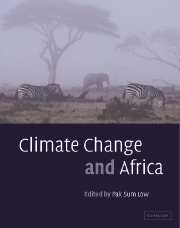Book contents
- Frontmatter
- Contents
- Notes on contributors
- Peer reviewers
- Editor's note
- Foreword
- Foreword
- Foreword
- Foreword
- Preface
- Preface
- Preface
- Preface
- List of abbreviations
- List of SI prefixes
- List of unit abbreviations
- List of chemical formulae
- Part I Science
- 1 Holocene climatic, hydrological and environmental oscillations in the tropics with special reference to Africa
- 2 The relative importance of the different forcings on the environment in Ethiopia during the Holocene
- 3 Global warming and African climate change: a reassessment
- 4 Interactions of desertification and climate in Africa
- 5 Africa's climate observed: perspectives on monitoring and management of floods, drought and desertification
- 6 Atmospheric chemistry in the tropics
- 7 Natural and human-induced biomass burning in Africa: an important source for volatile organic compounds in the troposphere
- 8 Biomass burning in Africa: role in atmospheric change and opportunities for emission mitigation
- 9 Soil micro-organisms as controllers of trace gas emissions over southern Africa
- Part II Sustainable energy development, mitigation and policy
- Part III Vulnerability and adaptation
- Part IV Capacity-building
- Part V Lessons from the Montreal Protocol
- Index
1 - Holocene climatic, hydrological and environmental oscillations in the tropics with special reference to Africa
Published online by Cambridge University Press: 10 December 2009
- Frontmatter
- Contents
- Notes on contributors
- Peer reviewers
- Editor's note
- Foreword
- Foreword
- Foreword
- Foreword
- Preface
- Preface
- Preface
- Preface
- List of abbreviations
- List of SI prefixes
- List of unit abbreviations
- List of chemical formulae
- Part I Science
- 1 Holocene climatic, hydrological and environmental oscillations in the tropics with special reference to Africa
- 2 The relative importance of the different forcings on the environment in Ethiopia during the Holocene
- 3 Global warming and African climate change: a reassessment
- 4 Interactions of desertification and climate in Africa
- 5 Africa's climate observed: perspectives on monitoring and management of floods, drought and desertification
- 6 Atmospheric chemistry in the tropics
- 7 Natural and human-induced biomass burning in Africa: an important source for volatile organic compounds in the troposphere
- 8 Biomass burning in Africa: role in atmospheric change and opportunities for emission mitigation
- 9 Soil micro-organisms as controllers of trace gas emissions over southern Africa
- Part II Sustainable energy development, mitigation and policy
- Part III Vulnerability and adaptation
- Part IV Capacity-building
- Part V Lessons from the Montreal Protocol
- Index
Summary
Keywords
Tropical Africa; Holocene climate; hydrological fluctuations; environmental oscillations
Abstract
The tropics have experienced large and sometimes abrupt fluctuations in the water balance since the beginning of the Holocene period. Water levels were generally high in the equatorial region and northern hemisphere at the beginning of the Holocene, a trend that was asynchronous with many southern hemisphere records. Apart from a desiccation event in many African lakes between 8, 000 and 7, 500 yr BP (Before Present), water levels continued to be high until c.5, 000 yr BP. Southern hemisphere sites experienced intermediate to high lake levels at c.6, 000 yr BP. The tropical lakes experienced a drying phase between 5, 000 and 3, 000 yr BP, and these arid conditions have continued to the present day. Tropical glaciers have, on the other hand, been gradually receding during the Holocene period, but there have been several minor advances. After about 8, 000 yr BP, glacial events show much less spatial consistency. The environmental response has been less marked, but the major trend is from wet/moist vegetation in the early Holocene to drier vegetation from the middle Holocene to the present. The climatic, hydrological and environmental oscillations of the low-latitude regions during the Holocene are linked to changes in earth surface temperatures, sea surface temperatures (SSTs), ocean and atmospheric circulation patterns, regional topography, land surface albedo, etc.
- Type
- Chapter
- Information
- Climate Change and Africa , pp. 3 - 22Publisher: Cambridge University PressPrint publication year: 2005
- 4
- Cited by



